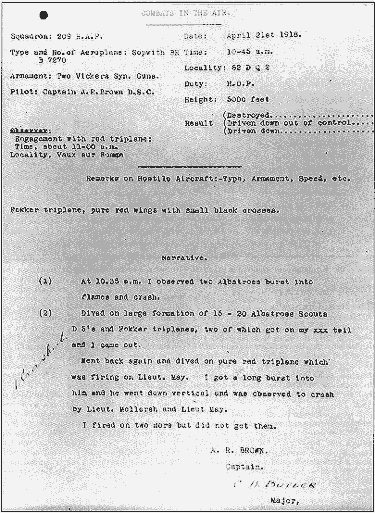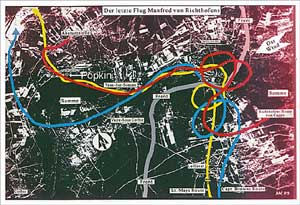April 21, 1918
The day started cold and foggy, but cleared by 9 A.M., so both British and German aircrews warmed up their fighters. Camel F1s for the British, Fokker Dr. I triplanes for the Germans. Richthofen flew in his standard red coloured triplane, Brown in his cherry-nosed Camel.
Both flights left their respective aerodromes around 9:15 and each ran into enemy two-seaters. Brown missed an Aviatik but one of his men cut it down. The Germans attacked a pair of Australian RE8s (upgraded RE7s), but lost a triplane before the Australians escaped. Both sides reformed and headed towards each other. Brown spotted the Germans first and motioned for Wop May to stay high out of danger and then led 209 Sqdn to the attack. The triplanes were more agile than the Camels, and Brown soon had two on his tail. He quickly slowed his plane and the triplanes roared past him. May watched from above until several Fokkers passed under him. He could stand it no longer and dove to the attack, spraying lead all over the sky. He missed everyone and had both guns jam. Happy with surviving his first battle May headed for Allied lines. But the Red Baron had spotted the rookie as the pilot he dove on was Wolfram. He tracked May as he left the melee and followed him.
The first time May knew that he was in trouble was when Richthofen's bullets smashed into his Camel. As a novice he had not developed the observational techniques required to stay alive in the air. He looked quickly over his shoulder to see a scarlet triplane on his tail firing at him. He dove quickly and zigzagged as he dropped. Richthofen stuck to him firing and matching the novice's moves.
I kept dodging and spinning, I imagine from about 12,000 feet until I ran out of sky and had to hedgehop over the ground. Richthofen was firing at me continually. The only thing that saved my life was my poor flying. I didn't know what I was doing myself and I do not suppose that Richthofen could figure out what I was going to do. We came over the German lines, troops firing at us as we went over. This was also the case coming over the British lines."
Brown saw that May was in desperate trouble and dove to engage the red Fokker from behind. He was a ways off and May had to fend for himself for several minutes. May wrote:
I got on the Somme River and started up the valley at a very low altitude, Richthofen very close on my tail. I went around a curve in the river just near Corbie. Richthofen beat me to it and came over the hill. At that moment I was a sitting duck. I was too low down between the banks to make a turn away from him, I felt that he had me cold, and I was in such a state of mind at this time that I had to restrain myself from pushing my stick forward into the river, as I knew that I had had it."
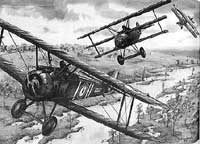 Brown was now in a position to fire. He pulled out of a steep dive
barely two plane lengths behind Richthofen and fired off 40 rounds. He
saw the German ace snap upright in his cockpit as Brown roared
past him. The Fokker continued on over Allied territory for another
minute and then nosed into the ground. As it descended it was
subjected to a hail of gun fire from Australian troops. The plane
wasn't badly damaged, but the Aussies found Baron Manfred von
Richthofen stone dead.
Brown was now in a position to fire. He pulled out of a steep dive
barely two plane lengths behind Richthofen and fired off 40 rounds. He
saw the German ace snap upright in his cockpit as Brown roared
past him. The Fokker continued on over Allied territory for another
minute and then nosed into the ground. As it descended it was
subjected to a hail of gun fire from Australian troops. The plane
wasn't badly damaged, but the Aussies found Baron Manfred von
Richthofen stone dead.
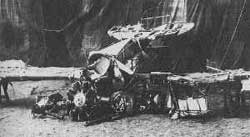 Quickly souvenir hunters hacked apart his aircraft before the British
army HQ staff could get there to take the body and aircraft back
for study. However, army surgeons had no interest in looking at
a dead German body to determine who's bullet killed him. They
had too many live British bodies to look after.
Quickly souvenir hunters hacked apart his aircraft before the British
army HQ staff could get there to take the body and aircraft back
for study. However, army surgeons had no interest in looking at
a dead German body to determine who's bullet killed him. They
had too many live British bodies to look after.
Richthofen was shipped off to Bertangles and placed in a hanger only a 100 yards from Brown's tent. After the morning patrol, Brown went in to see the mighty warrior he had killed, but the sight of the body sickened him. The similarities between Richthofen and himself were too great. It wasn't glamourous, Richthofen's eyes were open, his teeth were bashed in from the crash and he had a large gash on his chin. He wrote of that night:
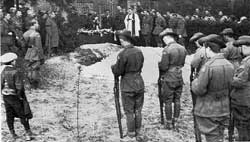
"... the sight of Richthofen as I walked closer gave me a start. He appeared so small to me, so delicate. He looked so friendly. Blond, silk-soft hair, like that of a child, fell from the broad, high forehead. His face, particularly peaceful, had an expression of gentleness and goodness, of refinement. Suddenly I felt miserable, desperately unhappy, as if I had committed an injustice. With a feeling of shame, a kind of anger against myself moved in my thoughts, that I had forced him to lay there. And in my heart I cursed the force that is devoted to death. I gnashed my teeth, I cursed the war. If I could I would gladly have brought him back to life, but that is somewhat different than shooting a gun. I could no longer look him in the face. I went away. I did not feel like a victor. There was a lump in my throat. If he had been my dearest friend, I could not have felt greater sorrow."
He was awarded his second DSC for the feat. The Australians gave Richthofen a military funeral with an honour guard near Bertangles. After the war he was exhumed by the Germans and reburied with honours in Berlin.
Brown's Combats in the Air Report
